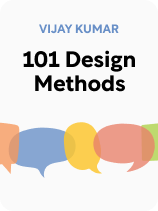

This article is an excerpt from the Shortform book guide to "101 Design Methods" by Vijay Kumar. Shortform has the world's best summaries and analyses of books you should be reading.
Like this article? Sign up for a free trial here.
What are the best innovation management tools? How are maps useful for keeping track of products in progress?
In 101 Design Methods, Vijay Kumar discusses many specific tools and techniques that can be useful for completing an innovation project. Two especially helpful tools are cluster maps and comparison tables.
Let’s dive into these innovation management tools so you can use them for your next project.
1. Two-Factor Cluster Maps
Arguably Kumar’s favorite innovation management tool (based on how many variations of it he presents and the scope of what he applies it to) is what we’ll call the two-factor cluster map. To create this map, label the two axes of a scatter plot with properties you want to compare. Then, mark on the plot where different products or services you’re researching fall. This may reveal important relationships or opportunities if you find that the dots cluster together in some areas while other regions of the plot are empty.
To understand how to use the map effectively, you need to know the seven tasks to complete an innovation project:
- Develop a clear idea of what you intend to accomplish
- Define your operating environment
- Understand your stakeholders
- Develop a mental model
- Brainstorm solution elements
- Assemble and evaluate comprehensive solutions
- Plan to implement the solution
For example, you might make a two-factor map comparing the price and user base of a certain type of service, as shown below:
In the example plot, the services you’re comparing are concentrated into two clusters: one at a very low price point and one at a moderately high price point. Between these two clusters is an empty region with no offerings. Maybe that void indicates an opportunity in an uncontested region of the market. Or maybe there’s a good reason that no offerings exist in that region. You’ll need more information to figure out why the voids and clusters exist, but the plot allows you to tell at a glance where they exist.
Applications for Two-Factor Cluster Maps
Kumar suggests several uses for two-factor cluster maps in different tasks. In Tasks 1 and 2, he recommends plotting companies and their offerings on maps with different combinations of factors to explore the dynamics of the industry and identify areas of opportunity. Sometimes you can gain additional insights by plotting competing products as dots and complimentary products as x’s or c’s (or any other marker that distinguishes them from competing products) on the same plot.
In Tasks 3 and 4, he suggests plotting users against different combinations of two factors (for example, age, level of income, frequency of use, how long they’ve been using the product, or their likelihood of renewing their subscription) to identify clusters of similar users. These clusters can serve as a starting point for building user profiles.
In Task 6, Kumar recommends plotting your solutions or solution elements with the value they would provide to the user on one axis and the profits they would provide to the company on the other axis. Seeing graphically how much value each solution provides to whom may make it obvious which solutions are most worth pursuing.
2. Comparison Table
Another innovation management tool Kumar uses extensively to compare properties of different products, services, or options is the comparison table. To build a comparison table, label the rows and columns of a table with the things you want to compare. Then, in the box where they intersect, describe how that row and column relate to each other. This ensures that you compare every possible combination.
If you want to compare several different products, you might list the products as rows and factors of interest as columns, as shown below. You can color-code boxes with similar results to make the similarities stand out.
After doing your initial comparison, you might rearrange the rows as shown below to make similarities and other patterns stand out more clearly. For example, in the table below, it is more obvious that Product X resembles an improved version of Product C, and that there’s an inverse relationship between cost and portability for most of these products.
Applications for Comparison Tables
In Task 1, Kumar recommends using a table to assess trends in technology, business, people, culture, and politics. Use these as columns and add as many rows as you want for different topics or market sectors. Briefly summarize the trends you’ve identified from media surveys or other research in each box.
Kumar notes that comparison tables are useful in Task 4 for identifying relationships and extracting trends from the data that you gathered in Tasks 2 and 3.
In Task 5, Kumar says you can use a comparison table to aid in brainstorming solutions: List the different phases of the product life cycle as columns and the user profiles or personas that you’ve identified as rows. Then brainstorm ways to improve the user experience for each archetypal user at each stage of the product life cycle.
In Task 7, Kumar recommends building a table that lists your company’s resources or capabilities as columns and the different phases of your solution implementation plan as rows. This helps you assess what resources or capabilities will be needed when so that you can develop your implementation schedule and budget.

———End of Preview———
Like what you just read? Read the rest of the world's best book summary and analysis of Vijay Kumar's "101 Design Methods" at Shortform.
Here's what you'll find in our full 101 Design Methods summary:
- Why many companies don’t understand how to manage innovation
- A systematic approach to innovation management
- Specific tools and techniques you can use on innovation projects






